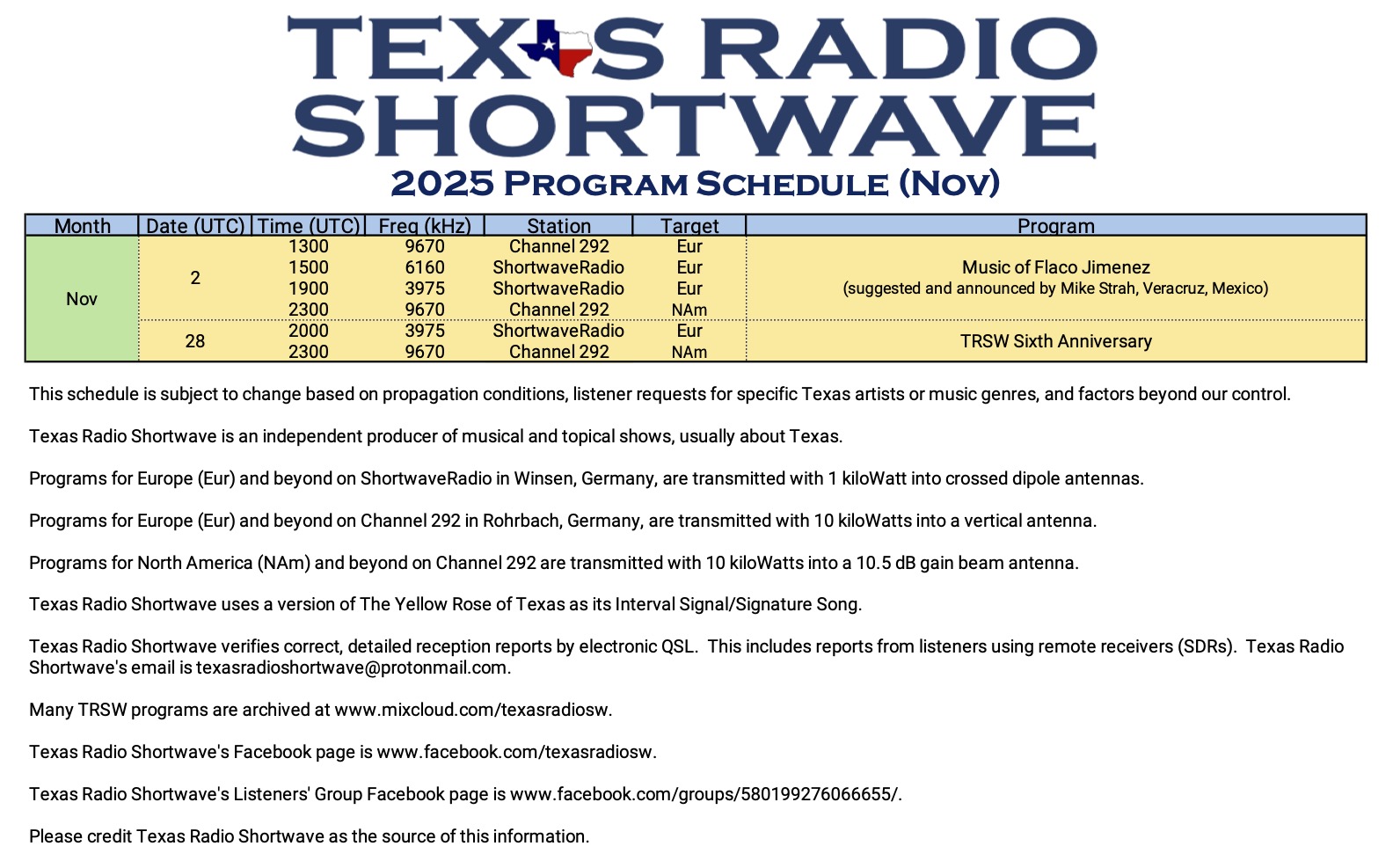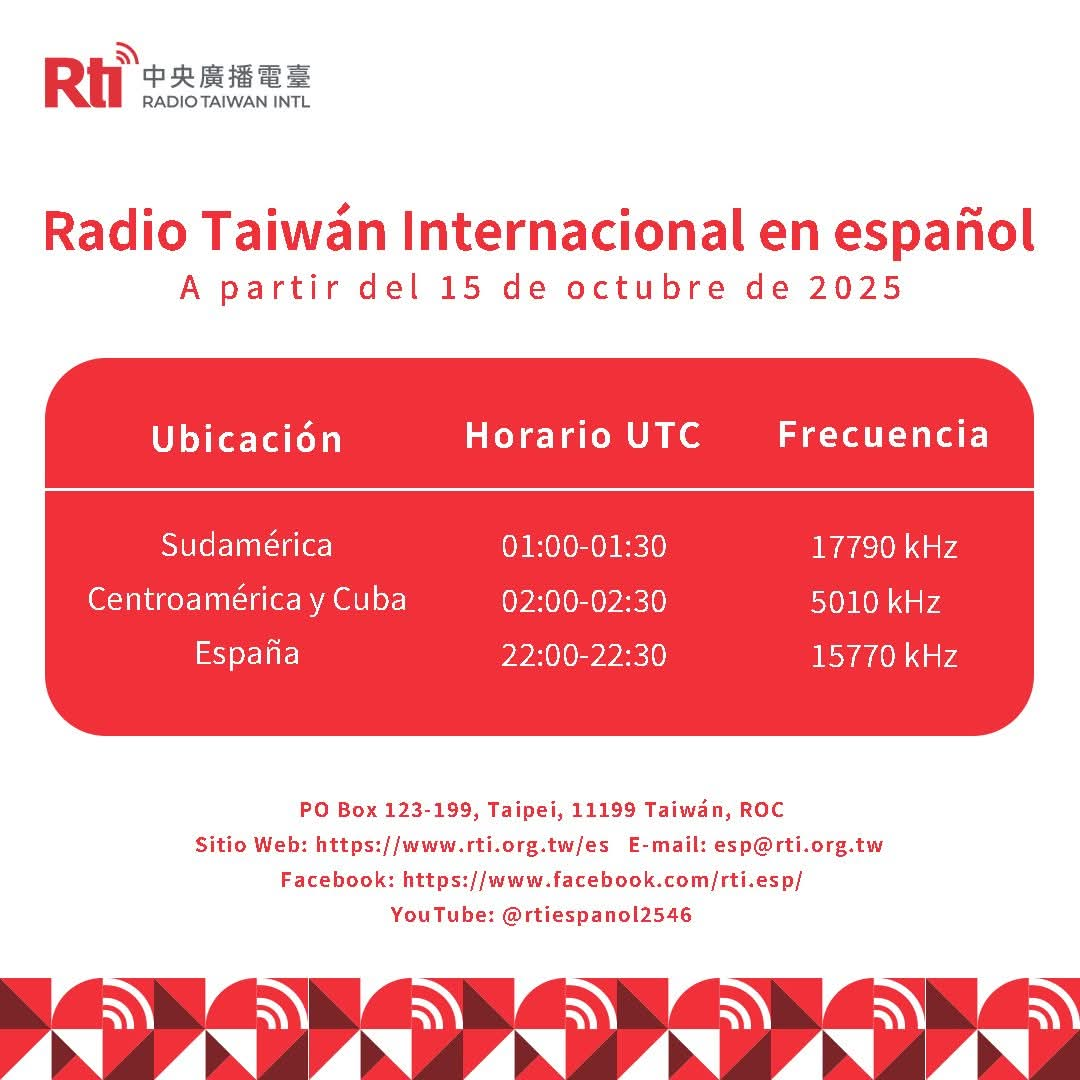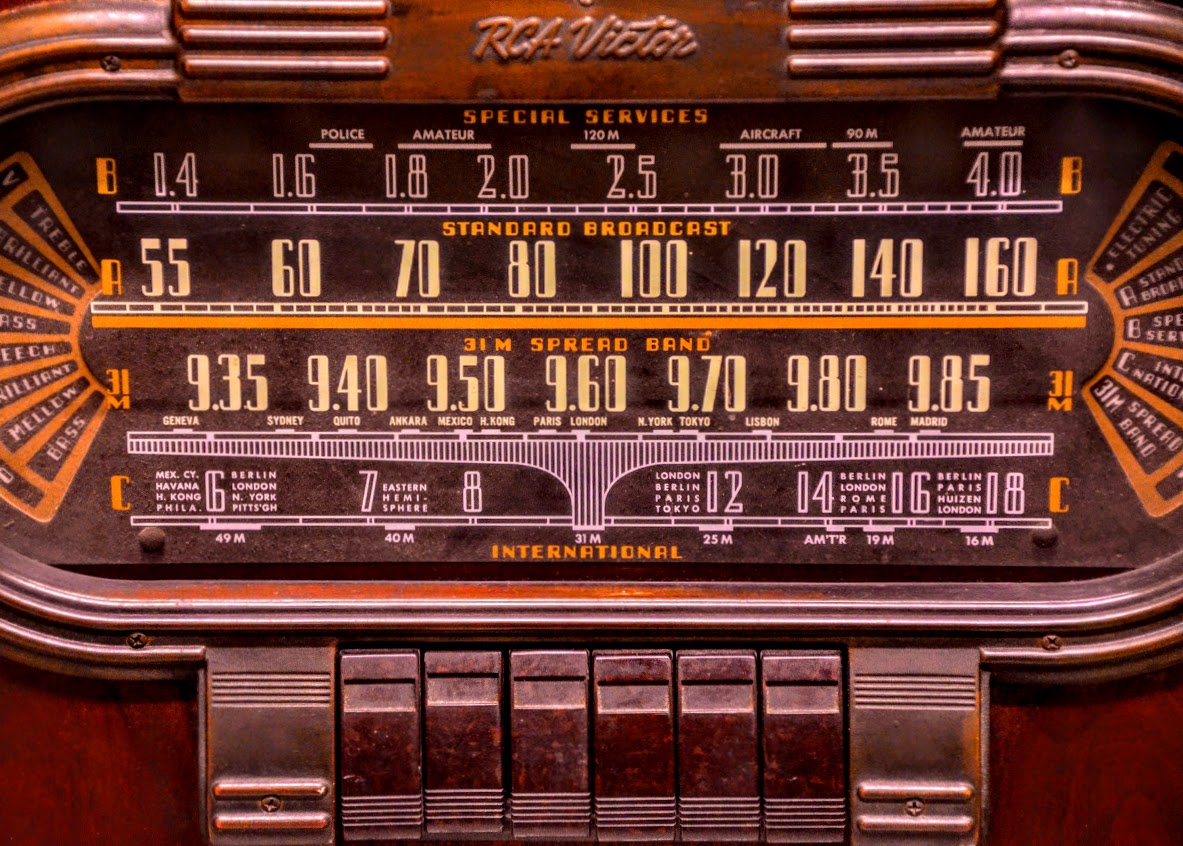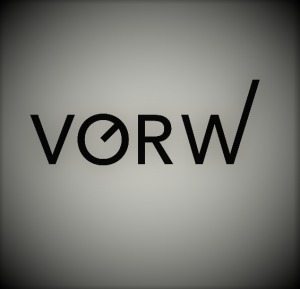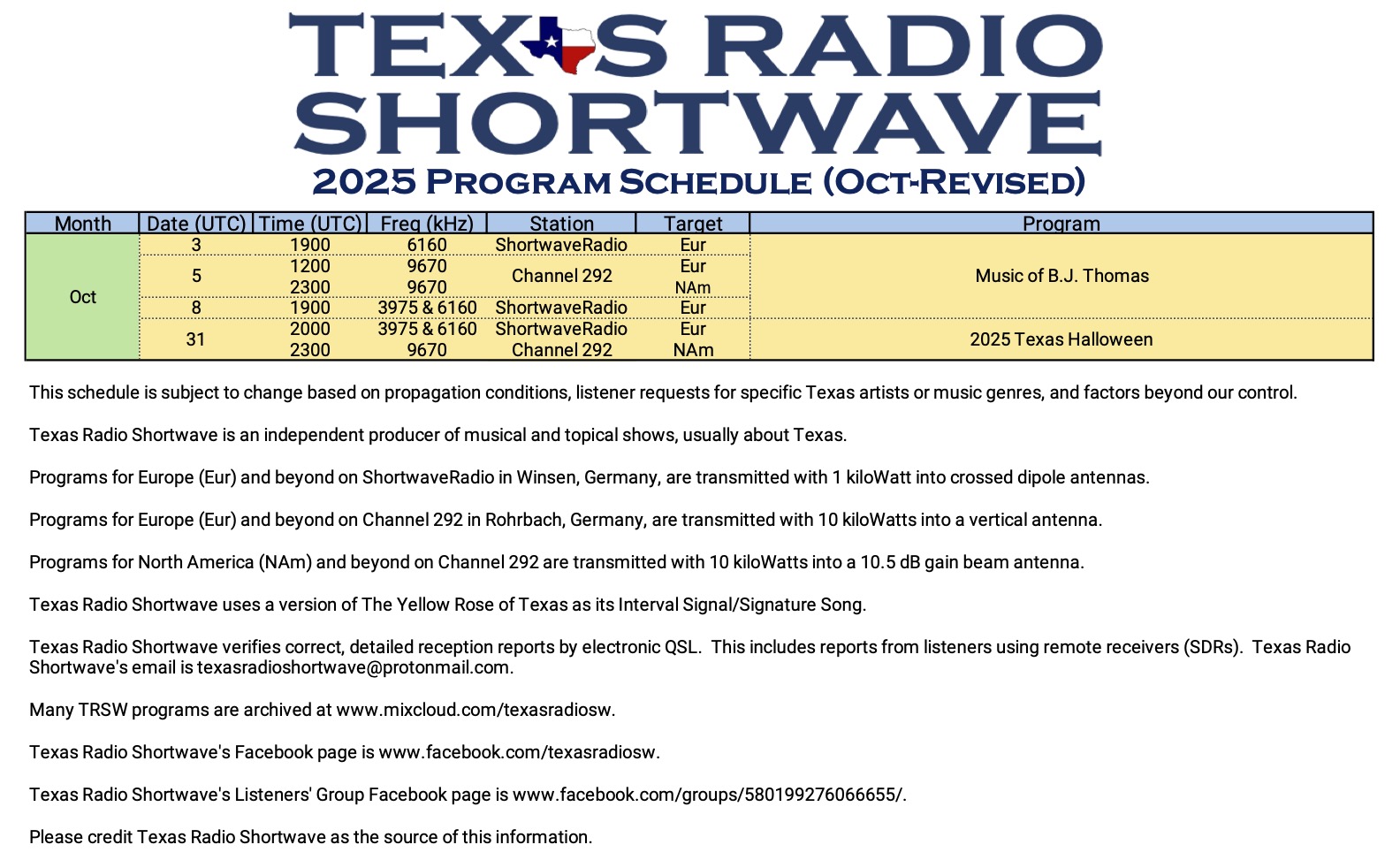 Many thanks to SWLing Post contributor Terry (N5RTC), who shares the following schedules for Texas Radio Shortwave (click image to enlarge):
Many thanks to SWLing Post contributor Terry (N5RTC), who shares the following schedules for Texas Radio Shortwave (click image to enlarge):
Category Archives: Schedules and Frequencies
RTI Spanish Language Service Update
October 16–19, 2025: Travel the World by Radio with The Eifeler Radiotage
 Many thanks to SWLing Post contributor Gérard Koopal for tipping us to this event:
Many thanks to SWLing Post contributor Gérard Koopal for tipping us to this event:
If you’re a radio lover, music fan, or just curious about broadcasting in an analog spirit, you’ll want to check out Eifeler Radiotage. The event is billed as “In 2½ Tagen um die Welt” (“Around the World in 2½ Days”) — a broadcast journey featuring vintage gear, vinyl, tape machines, and live music, without heavy reliance on digital tech.
Details:
- The official site has the full October 2025 program (in German) with schedule, segment descriptions, and times: Eifeler Radiotage Program October 2025
- Their homepage (in German) gives the theme, philosophy, and overall event info: Eifeler Radiotage
If you like slow radio, eclectic music, vintage broadcast flavors, or simply want a relaxing escape in sound, set aside time during the Eifeler Radiotage dates (see the October 2025 program) and tune in via shortwave, FM, or the livestream.
October 2025 Schedule Updates: From the Isle of Music & Uncle Bill’s Melting Pot
Many thanks to SWLing Post contributor, Bill Tilford, who shares the following update:
From the Isle of Music, October 2025
October’s program will be the final of several episodes featuring the best of Cubadisco 2025, Cuba’s most important discographic awards. This is the best of the best of Cuba’s new releases (and recordings from Cubans elsewhere) and will feature a sampling from several categories this month.
Friday, October 10:
6070 kHz at 1700 UTC
3955 kHz at 2100 UTC
Saturday, October 11:
9670 kHz at 1700 UTC using booster beam H to Africa (repeat of October 10 episode).
*Note that our Sunday broadcasts have been moved to Saturdays.
Uncle Bill’s Melting Pot, October 2025
In October we will a potpourri of recent releases from around the world.
All broadcasts are on Radio Channel 292 from Germany as follows:
Friday, October 17:
6070 kHz at 1700 UTC
3955 at 2100 UTC
Saturday, October 18:
9670 kHz at 1700 UTC using beam H (repeat of October 17 episode).
*Note that our Sunday broadcasts have moved to Saturdays.
**In addition to direct radio reception, we do honor reception reports using remote SDRs as long as the whole program is described and which SDR is specified.
Uncle Bill’s Melting Pot Encore Broadcast on September 28, 2025
Many thanks to SWLing Post contributor, Bill Tilford, who shares the following update:
Special Extra Broadcast of September’s Program
Channel 292 will air an encore broadcast of September’s UBMP featuring jazz from Russia and Ukraine on September 28, 2025 at 0300 UTC (11pm Eastern US) on 3955 kHz.
This is an experiment – although most Europeans are fast asleep, this is supposedly the hour of maximum reach for the frequency, and it may or may not touch parts of the world that don’t receive the transmission directly at the usual times. We are about to find out.
Late 2025 Broadcast Schedule for VORW Radio International!
Hello all! As some time has passed, I felt it appropriate to publish the latest schedule for my transmissions to North America and beyond!
My radio program is 1 Hour in length and features discussion (often about current events, other times about random subjects on my mind) at the start of the program and is then balanced out with listener requested music. I hope for it to be an enjoyable light entertainment program with good music and discussion!
There are two new shows each week, along with various repeat airings for listeners who might not be able to catch the new shows as they first air.
Main Broadcasts:
Saturday 0600 UTC (2 AM Eastern / 1 AM Central) – 4840 kHz – WWCR 100 kW – North America
Monday 0400 UTC (12 AM Eastern / 11 PM Central Sunday Evening) – 4840 kHz – WWCR 100 kW – North America
Repeat Airings:
Tuesday 0800 UTC (4 AM Eastern / 3 AM Central) – 5850 kHz – WRMI 100 kW – Western North America
Tuesday 2000 UTC (4 PM Eastern / 3 PM Central) – 15770 kHz – WRMI 100 kW – Eastern North America
Wednesday 2300 UTC (7 PM Eastern / 6 PM Central) – 9455 kHz – WRMI 100 kW – North America
Thursday 0200 UTC (10 PM Eastern / 9 PM Central) – 9395 kHz – WRMI 100 kW – North America
Thursday 1600 UTC (12 PM Eastern / 11 AM Central) – 15770 kHz – WRMI 100 kW – Eastern North America
Thursday 2200 UTC (6 PM Eastern / 5 PM Central) – 9955 kHz – WRMI 100 kW – South America
Saturday 0400 UTC (12 AM Eastern / 11 PM Central) – 15770 kHz – WRMI 100 kW – Europe/Middle East
Saturday 0700 UTC (3 AM Eastern / 2 AM Central) – 1300 kHz – WNQM 5 kW – Nashville, Tennessee
Saturday 2300 UTC (7 PM Eastern / 6 PM Central) – 5950 kHz – WRMI 100 kW – North America
Sunday 0100 UTC (9 PM Eastern / 8 PM Central) – 1490 kHz – WITA 1 kW – Knoxville, Tennessee
Monday 0000 UTC (8 PM Eastern / 7 PM Central) – 5950 kHz – WRMI 100 kW – North America
Listener reception feedback & reception reports are much appreciated at [email protected]
e-QSL’s are sent upon request!
Happy Listening!

